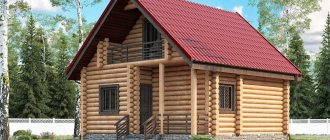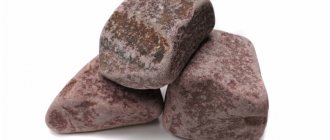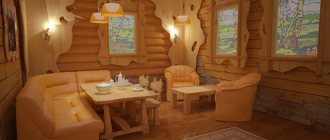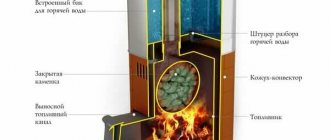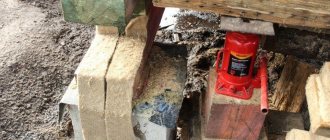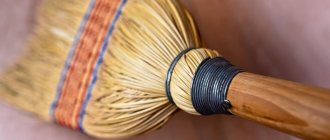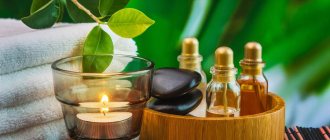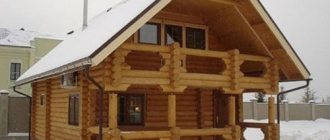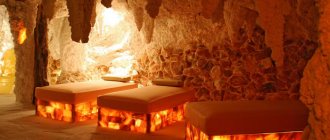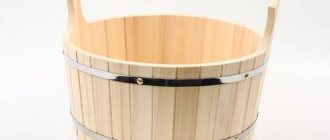The best stones for a sauna should have several basic properties: high thermal conductivity, excellent heat transfer, fast heating and safety. It’s not pleasant when a stone bursts in the steam room, scattering into small fragments. The choice must be approached carefully: avoid specimens with cracks and an abundance of veins. This top will help you choose useful stones for any steam room, sauna or classic bath.
Soapstone chlorite
pros
- resistant to temperature changes
- high heat capacity
- does not absorb water
- gives off heat for a long time
- does not enter into chemical reactions with liquids
- does not absorb odors
Minuses
- service life 3.5 years
- takes a long time to warm up
Natural stone, extracted from rocks. It tolerates high temperatures well, does not crumble or crack. It can heat up to 1600 degrees; when it cools, it releases vitamin D, which is especially useful for children for growth and strengthening bones. Suitable for both heat in a steam room and for lining walls. Produces soft steam and pleasant heat radiation.
Characteristics
The distinctive characteristics of the stone include its high hardness and strength. In addition, it is frost and moisture resistant. It has these properties due to the crystal lattice, which serves as the basis of its structure.
Gabbro-diabase is a holocrystalline fine-grained volcanic rock, chemically and in mineral composition close to basalt. Diabase is characterized by a relatively low silica content (45-52%). The structure is diabase (ophite); formed by randomly arranged elongated plagioclase crystals, the spaces between which are filled with augite. The name of this stone is derived from the Latin word “glaber”, which translates as “even, smooth”
Gabbro-diabase is a type of natural stone. Its inherent black color with minor colored spots distinguishes it from other types of stones. Its unusual density makes the stone very difficult to split. To process this material you need to use labor-intensive technological processes with special equipment.
Compared to other types of granite, gabbrodiabase has a low silica content (about 50%) and a high plagioclase content. Plagioclase is represented by a fine-grained (almost monolithic) structure of elongated crystals of the same size and shape.
The main indicators that are important for the use of stone are their density and heat capacity.
For convenience, see these characteristics of jade in the table. Table. Physico-chemical characteristics of gabbro-diabase
| Name of the stone | Density (kg/m³) | Heat capacity, kJ/(kg K) | average price |
| Gabbro-diabase | 2780-3230 | 0,6-0,8 | 300 rubles/20 kg |
Jade
pros
- very durable
- heats up quickly
- polished looks nice
- good heat capacity
- keeps warm for a long time
Minuses
- price
There are 3 types: chipped, boning and polished. When comparing the properties of bath stones: the latter is the most expensive and looks like jade (light green), its service life is 5 years. Gives soft warmth and lasts for a very long time. Suitable for cladding; tiles for steam rooms are made from jadeite. Avoid contact with open flames.
Bathhouse projects
Number of projects 681
- 2 rooms
Bani Pier Project
- To favorites
- 36² Total area
- 4 x 7m Construction area
from 450,000 rub.
Construction time individually
Barrel sauna project Compact with canopy
- To favorites
- 7² Total area
- 4 x 2m Building area
from 127,000 rub.
Construction time individually
- 1 room
- 2 bathrooms
Bathhouse project No. 14033
- To favorites
- 33² Total area
- 5 x 8m Building area
from 3,737,325 rub.
Construction time individually
Baths of Hygeia Project
- To favorites
- 12.5² Total area
- 4 x 4m Building area
from 168,750 rub.
Construction period 30 days
Project of the oktobahnaya bathhouse "Mega-2-SV"
- To favorites
- 2 x 5m Building area
from 269,900 rub.
Construction time 1 day
- 1 bathroom
Log bathhouse project BO-036
- To favorites
- 53² Total area
- 8 x 9m Construction area
from 715,500 rub.
Construction period 90 days
- 2 rooms
- 2 bathrooms
Altai Baths Project
- To favorites
- 66² Total area
- 11 x 9m Construction area
from 891,000 rub.
Construction time individually
- 1 room
- 1 bathroom
Bani B-11 project
- To favorites
- 6 x 9m Construction area
from 555,000 rub.
Construction period 14 days
- 1 room
Lazur Baths Project
- To favorites
- 12² Total area
- 4 x 4m Building area
from 350,000 rub.
Construction time individually
- 1 room
- 1 bathroom
Bathhouse project BKo-11
- To favorites
- 30² Total area
- 6 x 5m Construction area
from 405,000 rub.
Construction time individually
- 2 rooms
- 1 bathroom
Bathhouse project Privat-banya
- To favorites
- 114² Total area
- 11 x 8m Construction area
from 1,539,000 rub.
Construction period 50 days
- 1 room
- 2 bathrooms
Bani Frog Project
- To favorites
- 64² Total area
- 8 x 8m Construction area
from 1,140,300 rub.
Construction time individually
- 2 rooms
- 1 bathroom
Bani B-2 project
- To favorites
- 5 x 6m Construction area
from 470,000 rub.
Construction period 14 days
- 1 room
- 1 bathroom
Bathhouse Bereginya project
- To favorites
- 37² Total area
- 8 x 6m Construction area
from 499,500 rub.
Construction period 30 days
- 1 room
- 2 bathrooms
Project Baths 5B-B
- To favorites
- 18.55² Total area
- 5 x 5m Building area
from RUB 300,159
Construction period 17 days
- 3 rooms
- 3 bathrooms
Bani Premier project
- To favorites
- 280² Total area
- 16 x 16m Construction area
from 3,198,300 rub.
Construction time individually
- 1 bathroom
Bani Medveditsa project
- To favorites
- 47² Total area
- 4 x 11m Construction area
from RUR 699,223
Construction time individually
- 1 bathroom
Bathhouse Ryblovo project
- To favorites
- 39² Total area
- 6 x 7m Construction area
from 850,000 rub.
Construction time individually
- 1 room
- 2 bathrooms
Bani Khvoynaya project
- To favorites
- 66² Total area
- 9 x 9m Construction area
from 891,000 rub.
Construction period 35 days
- 1 room
- 1 bathroom
Bath Velizh Project
- To favorites
- 20² Total area
- 5 x 4m Building area
from 139,000 rub.
Construction time individually
View all projects
For many people, a bathhouse is a whole lifestyle. The steam room has a healing effect on the body; in addition, the washing process is exciting entertainment. Therefore, we will help you figure out which bath stones are best to choose to ensure good quality steam, healing fumes and uniform heating. Read to the end and find out what properties a bath stone should have, what rocks are suitable for a steam room and how to use them.
A stove with a heater is the most important component of any sauna.
Dunit
pros
- lasting
- high thermal conductivity
- uniform heat
- disinfects the air
- maintains temperature for a long time
Minuses
- with a high percentage of sulfur in the composition it breaks down into parts
- gloomy look
Dunite is soapstone, which is located deeper, igneous rock, absolutely free from radiation. When choosing, you need to focus on the number of sulfur veins; if there are more than 5% of them, you should refuse the purchase. It heats up quickly and well, and also cools quickly, durable (if it is of high quality). Suitable for the first layer of stones, as it is not visually attractive.
How to lay stones in a sauna stove
You need to focus on the size of the bath. For purchased heaters, the instructions indicate the recommended weight and area of the steam room. For home-made structures, the amount of minerals is taken at the rate of 6 kg per 1 m3. If it does not warm up enough, their volume is increased. If there is an uncomfortable increase in temperature or strong steam, reduce it.
For an iron stove, it is allowed to combine mineral filler with cast iron in a 1:1 ratio. But the weight of the backfill will also increase by at least 20% of the recommended weight. Only cast iron cones are taken at the rate of 14 kg/1 m3.
Principles of filling a sauna stove:
- before filling, check the integrity of the samples and the absence of harmful inclusions;
- for baths use only washed, hardened and dry filler;
- wash with warm water and a stiff brush;
- after washing, the stones can be soaked in a weak saline solution for 2 hours;
- large stones are placed on the bottom, then medium-sized ones, and small ones on top;
- you can use samples of the same size measuring 8–15 cm;
- when laying, minerals are placed vertically on the end;
- Gaps are left between adjacent samples (corridors for steam and air);
- in electric furnaces they also leave voids between the filler and the heater tubes.
The stones are laid tightly. Up to 15% of the resulting volume of filler should fall on the air corridors.
In addition to the topic, a video about laying stones:
Raspberry quartzite
pros
- record low radiation levels
- Maintains room temperature for a long time
- beautiful colour
- is not destroyed by chemical reactions with liquids
- high hardness
- withstands temperatures up to 2700 degrees
Minuses
- Often there are copies with cracks in boxes
Very beautiful dark crimson color, withstands high temperatures, minimal radioactivity. Heats up quickly and gives soft warmth. According to reviews, it helps against respiratory and cardiovascular diseases. It consists of 93% quartzite, heats up smoothly, and releases heat evenly. Suitable for long-term use, often used in public baths. There are many copies with cracks, you need to control this when purchasing.
Basalt (volcanic)
pros
- the best breed for a bath
- refractory
- soothing, good for blood circulation
- long service life
- retains heat well
- the most durable
Minuses
- not detected
The best stones for the stove are of volcanic origin. Black in color, has high thermal conductivity, gains temperature well, and releases heat slowly. Withstands many cycles of temperature changes. Very durable, according to experts, there is a high chance that you will never need to change it at all, it will last for the entire service life of the bathhouse.
Types and deposits
Diabase differs by type depending on its composition, origin and properties. The composition of diabase can be distinguished:
- quartz,
- enstaite,
- olivine,
- biotite,
- calcite,
- limonite
- and others.
According to its composition, the stone can be divided into several parts:
- ordinary or olivine-free
- dolerites or olivine
- quartz.
- Also among these groups there are types of stones: Saussurian, leucophyre, mica, low-colite and other types.
Among the large deposits, three main deposits are noted: the Russian Prionezhye, the Crimean Peninsula, Australia and China. Crimean diabase is considered one of the cheapest; it contains many iron impurities, which significantly reduces the quality of the raw material.
This material is not suitable for use in baths and saunas. It found its application in the manufacture of tombstones.
The highest quality material for this is gabbro-diabase from Karelia and Australia. In terms of their characteristics, these rocks are superior to Chinese and Crimean stones.
Karelian stone (cheaper than Australian stone) has unsurpassed characteristics (durable, frost-resistant, accumulates and releases heat well), and excellent decorative properties. Reviews from buyers show that in addition to durability, stones also have unique abilities to retain heat.
Diabase has gained its popularity due to its good heat dissipation. The cost of the stone is not high, so it is popular.
In industry, gabbro stone is used as facing and piece stone, crushed stone for concrete, railway ballasting, and road construction.
White quartz
pros
- spectacular white color
- heats up quickly
- gives off heat well
- cools down slowly
- fragrant
Minuses
- when broken, forms sharp edges
- cannot withstand high temperatures
The vein rock breaks over time due to frequent temperature changes; you need to monitor the condition and replace it with a new one if cracks appear. Beautiful white color, looks impressive in combination with dark stones. It is believed that it produces ozone, which is why it is called hot ice, but no research has been conducted on this topic. It has only been proven that energy accumulates on the surface and a piezoelectric effect appears. Suitable for saunas that do not heat up very much (in fitness clubs, swimming pools).
Rules for choosing a quality mineral
When choosing stones for a bath, you should first study the information about what they should be. During the selection process, it is recommended to adhere to the following recommendations:
- the shape must be round and the surface smooth - all this contributes to good air circulation and heating;
- if the heater is small in size, then the selected rocks should be small;
- there should be no inclusions of other types of rock, mica and defects that will lead to rapid destruction;
- Before you start using stones, you need to first check them for cracks and chips.
As a test, it is recommended to heat the stone and place it in ice water - the rock should not split after this.
Advice! The ideal option is to select boulders whose size varies from 5 to 20 cm.
Peridotite
pros
- does not contain harmful impurities
- high specific heat capacity
- does not crack
- takes a long time to cool down
- creates thick steam
Minuses
- service life up to 3 years
One of the safest, environmentally friendly. Able to withstand many cycles of temperature changes, cracks will not appear. High melting point (1850 degrees), heat transfers well, releases for a long time, the steam is thick and rich. Capable of withstanding heavy loads. Suitable for sauna stove.
Criteria for choosing fillers for the stove
You can design the heater yourself if you have time to search for suitable stones, or purchase a ready-made kit in the store.
But not every breed will adequately withstand the peculiarities of the sauna microclimate, so we will consider the main characteristics that you need to pay attention to when choosing a filler for the stove.
Heat resistance, strength and structure
The main purpose of bath stones is to heat up quickly and retain heat for as long as possible. Not only its service life, but also the amount of steam, fuel consumption for the stove and the overall comfort of staying in the bathhouse directly depend on the heat capacity and heat resistance of the filler.
The “correct” stones can be identified upon inspection - they will have a non-porous structure and a high specific gravity.
Heat-resistant rocks, for example, dunite or jade, can last a decade, but the average lifespan of most stones is 3-4 years, after which the rock begins to crumble, smoke and dust.
The higher the density of the rock, the better the stone tolerates temperature changes in the steam room, warms up faster and cools down more slowly
To test the strength of the stones, you can hit them with a metal hammer or against each other - if the sound is dull, such a filler will not last long
It is important that the material is homogeneous, without any foreign inclusions, because they can cause the stone to explode at high temperatures.
Experienced bathhouse attendants have a great way to determine which stones are ideal for a steam room in a bathhouse, but you can only use it in practice: heat it red-hot and throw it into cold water.
A truly high-quality filler will easily withstand this test without forming cracks or splits.
Optimal size and weight of stones
The size of the stones directly depends on the type of sauna stove, so they need to be chosen practically, guided not only by design considerations.
For example, for a sauna with an open heater, which heats the air to 100 degrees and above, you should use only large and medium format samples.
The best shape is rounded pebbles that are smooth to the touch - they will produce less debris, and they look more aesthetically pleasing than chipped rock fragments
For an electric heater, choose small pebbles with a diameter of 4-6 cm, and the stones must be well polished so that their sharp edges do not deform the heating element.
In a wood-burning stove, specimens of the medium and large fraction, 6-18 cm in size, will last longer. Small stones are not used here so as not to block the openings of the stove grate.
The amount of filler is selected individually, based on the size of the room and the type of oven. If there are not enough stones, the sauna will not warm up well, despite the increased fuel consumption. With a large load, the heater will produce intense steam and heat, in which not every bathhouse attendant will be comfortable.
The instructions for purchased heaters must indicate the recommended weight and fraction of stones. For homemade saunas, you can focus on average figures: about 6 kg of stone is required per 1 m2 of room.
In closed heaters, cast iron cores or other inexpensive fillers with good heat transfer are often used, decorating only the upper layers with natural minerals
For a classic bath with a closed stove, the dimensions of the filler depend on the size of the door designed to supply water. Here, grinding is not so important, the main thing is that the stones pass freely through the hole and are compactly located inside.
Environmental safety of the filler
If our ancestors could collect stones for a steam room without thinking about environmental problems, then in modern realities such savings can be costly.
For example, you should not take various stones from the embankment near the railway for a sauna stove - they can be treated with creosote. This chemical does not erode or wash away and turns into a toxic vapor when heated. The same applies to cobblestones from construction sites or dumps.
The most budget-friendly filler for a stove is river or sea pebbles, but with regular use of a bathhouse, such stones quickly break down and need to be regularly inspected and replaced.
Do not forget that natural material may contain radionuclides, for example, granite. Therefore, the safest option would be to buy stones in specialized stores. In this case, you will be sure that the product has passed radiation control.
However, you can safely buy rocks that were formed at great depths, such as peridotite, jadeite or dunite - they cannot contain radioactive elements.
Porphyrite
pros
- good heat capacity
- low radioactivity
- inexpensive
- light pleasant steam
- heats up quickly
Minuses
- low strength
- contains sulfides
Its composition is similar to jadeite (oxides of silica and metals). Due to sulfides, it is less durable and can withstand temperature changes for about 2-3 years. Environmentally friendly, free from radiation. Creates thin, light steam. Suitable for those who rarely use the sauna. When purchasing, you need to check the number of veins in the stone (no more than 5%).
What is the best stone for a bath?
There can be no definite answer here. We said:
- the most durable - jade, ceramics and stainless steel;
- the most heat-intensive is porphyrite;
- the safest are jadeite, dunite, peridotite (and all of them are not immune to sulfides, by the way)
- the cheapest is gabbro-diabase.
And if we add to this what the owners of saunas with heaters filled with jade say... The quality of the steam also matters, right?
Therefore, we are still forced to cheat a little and say a completely expected banality:
- if you have the financial opportunity , it is worth buying jade, jadeite, ceramics and stainless steel;
- if the bathhouse is budget , then it is better to opt for porphyrite, gabbro-diabase and dunite.
And, of course, you are free to mix stones - natural or artificial - at your discretion.
We do not recommend taking quartz, basalt, serpentine (serpentinite) , rodingite, granite and jasper.
Soapstone is better than soapstone because magnesite is more heat resistant than chlorite.
If our opinion is not enough, read user reviews and the rating (in the compilation of which, by the way, each of you can take part).
Cast iron stones
pros
- heat up very quickly
- durable
- long service life
- no harmful impurities
- keep warm for a long time
Minuses
- the steam is dry and hot
Cast iron is used in the form of kernels or cones, placed at the very bottom of the furnace “on the butt”. Cast iron heats up well, 5 times faster than stones. Afterwards it holds the temperature for a long time. The elements are usually the same in shape and take up less space. Suitable for quickly heating up baths, environmentally friendly.
How to care for stones in a steam room
Sellers and bathhouse attendants recommend an annual inspection of the stones in bathhouses with any type of stove. If the steam room is used intensively, they are checked quarterly or once every six months.
Minerals in the bath are also inspected if steam formation, heat transfer deteriorate, or an unpleasant odor appears. If the steam room is used in business, then the stove filler is cleaned monthly.
Instructions for cleaning minerals from the bath:
- The cooled stones are lowered into a container with warm water. Do not add household or chemical products: they then evaporate and pollute the air.
- The backfill is left in the water for 90 minutes (the stones should become slippery).
- The stone is cleaned with a stiff brush on all sides.
- After cleaning, the backfill must be washed in clean water.
- Dry in a ventilated place.
- In good lighting, inspect each stone. Instances with signs of cracks are discarded.
- Lightly tap each sample in the center with a hammer. A mineral with a ringing sound is suitable for further use.
- Damaged samples are replaced, restoring the primary volume of the filler.
Stains from beer, honey or oils may not be washed off. When refilling, these samples are placed clean side up or covered with new filler.
It is better to create a pleasant smell in baths with a solution of hot water and aromatic substances. The liquid is poured into an iron ladle and placed on top of the stones.
Watch a video about how to preserve a stone structure for a long time:
Nephritis
pros
- high strength
- the most durable (up to 10 years)
- can be used on open fire
- heats up quickly
- high heat transfer
- the steam is soft
Minuses
- price
The ranking of bath stones puts jade in first place. It is characterized by durability and high thermal conductivity. Heats up very quickly, the steam cleanses, soothes, improves metabolism. Suitable for any heater, the only negative is that it is expensive. Because of this, it is often crafted; in order to distinguish the original, you need to hit it with a hammer - real jade does not split. It is sawed to be cut into pieces.
How to choose the right jade and avoid being scammed
Jade stones for baths
It was not for nothing that we paid so much attention to the formation of jade above. serpentinite (coil) instead of it (or together with it) This is no coincidence, because in most cases they coexist in nature. However, the coil is not suitable for a bathhouse - there it quickly becomes unusable.
IMPORTANT! It is not difficult to distinguish jade from a coil: it is extremely difficult, almost impossible, to split jade, but a coil can be easily and easily split with a hammer . You can also use a knife - serpentine is soft (3.5 Mohs) and is easily scratched with a knife , which cannot be said about jade.
It goes without saying that any chipped stones passed off as jade will be fake.
If jade is combined with talc rocks or serpentinite, its quality is much worse than in its pure form. It's better not to take this one. And the same knife or steel needle will help you decide - the blade of the knife or the tip of the needle has a hardness of up to 5.5 Mohs. The hardness of jade starts at 5.5.
Unfortunately, there are many similarities between jade and chalcedony . Chalcedony is fibrous quartz. You can distinguish them by hardness (chalcedony has a hardness of 7, jade has a hardness of 5.5-6). A thin file made of good steel with a hardness of 6.5 will do - it will leave a scratch on jade, but not on chalcedony .
IMPORTANT! In addition, chalcedony can be split - the fracture occurs parallel to the fibers, resulting in a rough surface.
Useful video
We recommend watching the following video, which demonstrates ways to distinguish between real jade and counterfeits:
